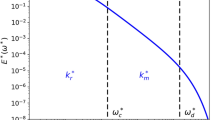Abstract
This study evaluates the recently developed general framework for solution verification methods for large eddy simulation (LES) using implicitly filtered LES of periodic channel flows at friction Reynolds number of 395 on eight systematically refined grids. The seven-equation method shows that the coupling error based on Hypothesis I is much smaller as compared with the numerical and modeling errors and therefore can be neglected. The authors recommend five-equation method based on Hypothesis II, which shows a monotonic convergence behavior of the predicted numerical benchmark (S C ), and provides realistic error estimates without the need of fixing the orders of accuracy for either numerical or modeling errors. Based on the results from seven-equation and five-equation methods, less expensive three and four-equation methods for practical LES applications were derived. It was found that the new three-equation method is robust as it can be applied to any convergence types and reasonably predict the error trends. It was also observed that the numerical and modeling errors usually have opposite signs, which suggests error cancellation play an essential role in LES. When Reynolds averaged Navier-Stokes (RANS) based error estimation method is applied, it shows significant error in the prediction of S C on coarse meshes. However, it predicts reasonable S C when the grids resolve at least 80% of the total turbulent kinetic energy.
Similar content being viewed by others
References
Roache P. J. Verification and validation in computational science and engineering [M]. Albuquerque, New Mexico, USA: Hermosa Publishers, 1998.
Roache P. J. Fundamentals of verification and validation [M]. Albuquerque, New Mexico, USA: Hermosa Publishers, 2009.
Oberkampf W. L., Roy C. J. Verification and validation in scientific computing [M]. Cambridge, UK: Cambridge University Press, 2010.
Eça L., Hoekstra M. A procedure for the estimation of the numerical uncertainty of CFD calculations based on grid refinement studies [J]. Journal of Computational Physics, 2014, 262: 104–130.
Stern F., Wilson R. V., Coleman H. W. et al. Comprehensive approach to verification and validation of CFD simulations-Part 1: Methodology and procedures [J]. Journal of Fluids Engineering, 2001, 123(4): 793–802.
Stern F., Wilson R., Shao J. Quantitative V&V of CFD simulations and certification of CFD codes [J]. International Journal for Numerical Methods in Fluids, 2006, 50(11): 1335–1355.
Xing T., Stern F. Factors of safety for Richardson extrapolation [J]. Journal of Fluids Engineering, 2010, 132(6): 061403.
Xing T., Stern F. Closure to "Discussion of 'Factors of Safety for Richardson Extrapolation'" (2011, ASME J. Fluids Eng., 133, p. 115501). Journal of Fluids Engineering-Transactions of ASME, 2011, 133(11): 115502.
Meyers J., Sagaut P. Is plane-channel flow a friendly case for the testing of large-eddy simulation subgrid-scale models? [J]. Physics of Fluids, 2007, 19(4): 048105.
Geurts B. J., Frӧhlich J. A framework for predicting accuracy limitations in large-eddy simulation [J]. Physics of Fluids, 2002, 14(6): L41–L42.
Celik I. B., Cehreli Z. N., Yavuz I. Index of resolution quality for large eddy simulations [J]. Journal of Fluids Engineering, 2005, 127(5): 949–958.
Celik I., Klein M., Janicka J. Assessment measures for engineering LES applications [J]. Journal of Fluids Engineering, 2009, 131(3): 031102.
Gousseau P., Blocken B., Van Heijst G. J. F. Quality assessment of Large-Eddy Simulation of wind flow around a high-rise building: Validation and solution verification [J]. Computers and Fluids, 2013, 79(Suppl. C): 120–133.
Klein M. An attempt to assess the quality of large eddy simulations in the context of implicit filtering [J]. Flow, Turbulence and Combustion, 2005, 75(1): 131–147.
Freitag M., Klein M. An improved method to assess the quality of large eddy simulations in the context of implicit filtering [J]. Journal of Turbulence, 2006, 7: N40.
Xing T. A general framework for verification and validation of large eddy simulations [J]. Journal of Hydrodynamics, 2015, 27(2): 163–175.
Dutta R., Xing T. Quantitative solution verification of large eddy simulation of channel flow [C]. Proceedings of the 2nd Thermal and Fluid Engineering Conference and 4th International Workshop on Heat Transfer, Las Vegas, USA, 2017.
Pope S. B.Turbulent flows [M]. Cambridge, UK: Cambridge University Press, 2000.
Yoshizawa A., Horiuti K. A statistically-derived subgridscale kinetic energy model for the large-eddy simulation of turbulent flows [J]. Journal of the Physical Society of Japan, 1985, 54(8): 2834–2839.
Dejoan A., Schiestel R. LES of unsteady turbulence via a one-equation subgrid-scale transport model [J]. International Journal of Heat and Fluid Flow, 2002, 23(4): 398–412.
Smagorinsky J. General circulation experiments with the primitive equations: I. The basic experiment [J]. Monthly Weather Review, 1963, 91(3): 99–164.
Germano M., Piomelli U., Moin P. et al. A dynamic subgrid-scale eddy viscosity model [J]. Physics of Fluids A: Fluid Dynamics, 1991, 3(7): 1760–1765.
Nicoud F., Ducros F. Subgrid-scale stress modelling based on the square of the velocity gradient tensor, flow [J]. Turbulence and Combustion, 1999, 62(3): 183–200.
Kim J., Moin P., Moser R. Turbulence statistics in fully developed channel flow at low Reynolds number [J]. Journal of Fluid Mechanics, 1987, 177: 133–166.
De Villiers E. The potential of large eddy simulation for the modelling of wall bounded flows [D]. Doctoral Thesis, London, UK: University of London, 2007.
Gullbrand J. Grid-independent large-eddy simulation in turbulent channel flow using three-dimensional explicit filtering [C]. Annual research briefs: Center for Turbulence Research, San Francisco, USA, 2003.
Acknowledgement
The authors would like offer gratitude to Idaho National Laboratory (INL) for providing HPC resources for running all the simulations.
Author information
Authors and Affiliations
Corresponding author
Rights and permissions
About this article
Cite this article
Dutta, R., Xing, T. Five-equation and robust three-equation methods for solution verification of large eddy simulation. J Hydrodyn 30, 23–33 (2018). https://doi.org/10.1007/s42241-018-0002-0
Received:
Accepted:
Published:
Issue Date:
DOI: https://doi.org/10.1007/s42241-018-0002-0




